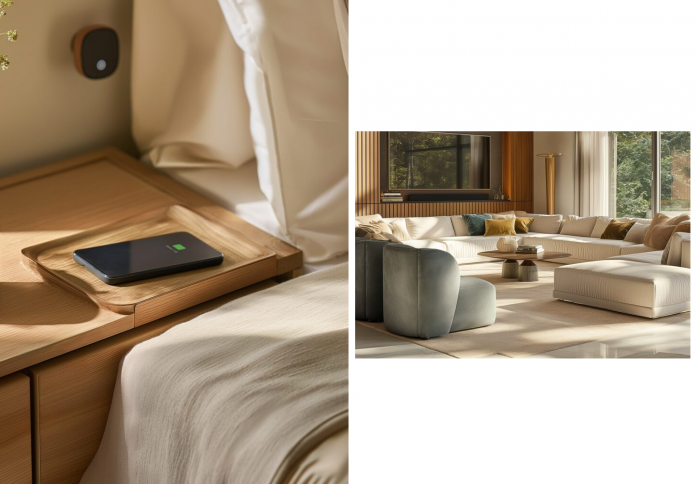Smart technology is no longer an add-on in today’s homes—it’s becoming the very framework of how we live. In the evolving world of interior design, the fusion of intelligent systems with aesthetic vision is redefining both comfort and style. From lighting that anticipates your presence to climate systems that learn your preferences, smart home interior design is transforming living spaces into adaptive, intuitive environments.
Redefining the home through technology
The modern home is no longer just a space to inhabit—it’s an ecosystem that interacts with its residents. As smart home technology matures, it is fundamentally changing the way interior spaces are designed, experienced, and understood. This transformation goes beyond mere convenience. It’s about creating environments that reflect and respond to our routines, emotions, and values.

Gone are the days when tech gadgets stood out like awkward accessories in a carefully curated room. Today, interior designers are embracing technology as a core design element, integrating it seamlessly into walls, lighting, furniture, and layouts. Think of voice-controlled blinds that adjust to the sun’s position, or ambient lighting that shifts with your mood. These features are not only functional—they are redefining what it means to feel “at home.”
What is smart home interior design?
At its core, smart home interior design blends the physical beauty of a space with the cognitive intelligence of digital systems. It’s more than adding a few smart speakers or a digital thermostat. It involves a holistic approach that considers how each smart element—lighting, temperature control, entertainment, and security—can integrate invisibly into a home’s design language.

While traditional design focuses on layout, color, and texture, smart interior design adds a new layer: responsiveness. The result? Homes that anticipate your needs, enhance your routines, and reflect your lifestyle on a deeply personal level. It’s design that thinks, adapts, and evolves.
Essential elements of integrated smart homes

A fully realized smart home is built on interoperability—where various technologies work together in harmony. When designing for this, functionality and visual consistency must go hand in hand. Some of the key components include:
- Smart lighting systems: These offer programmable scenes, motion detection, and remote control, adapting brightness and color temperature to time of day or mood—while blending into ceilings or walls with minimal hardware.
- Climate control: Devices like Nest or Ecobee use occupancy sensors and learning algorithms to fine-tune your home’s temperature, reducing energy use while maximizing comfort.
- Home security: Discreet smart cameras, doorbell facial recognition, and invisible locking mechanisms create peace of mind without disrupting the interior aesthetic.
- Audio-visual integration: Centralized systems that control music, screens, and streaming platforms allow users to curate the sound and sight experience of a room with a tap or voice command.
- Smart hubs and interfaces: Platforms like Google Home, Amazon Alexa, and Apple HomeKit serve as the control center, tying devices together with intuitive commands.
Each component is carefully chosen not just for its capabilities, but for its ability to disappear into the design. The goal isn’t to showcase the technology—it’s to make its presence feel natural, even invisible.
Comfort by design: lighting and climate control
Lighting and temperature have always played a critical role in the feel of a home. Smart technology takes that control to an entirely new level. Modern smart systems adjust brightness and warmth throughout the day to match circadian rhythms, helping regulate sleep and productivity.
Imagine a bedroom where the lights gradually brighten like a sunrise, the curtains draw open on schedule, and your favorite music begins to play—all without touching a switch. In living spaces, smart thermostats learn when you’re home and adjust accordingly, while blinds lower automatically during peak sun hours to keep things cool. This form of environmental intelligence allows your home to support your lifestyle in subtle but powerful ways, enhancing well-being and comfort without drawing attention to itself.
Invisible security: automation and peace of mind
Security is essential to comfort, and smart design is making it effortless and almost invisible. Instead of bulky systems or intrusive alarms, today’s smart homes feature embedded technologies: motion sensors, automated door locks, AI-powered cameras, and lights that mimic occupancy when you’re away.
Designers now embed these features into walls, doors, and even window frames, making them nearly undetectable. Windows that automatically shut during storms or alerts triggered by suspicious activity aren’t just security features—they’re part of the home’s built-in intelligence. This integration ensures that peace of mind doesn’t come at the cost of beauty. Like great design, security in a smart home is meant to be felt, not seen.
Beyond convenience: redefining comfort and wellness
The value of smart interior design extends beyond functionality. It minimizes the friction of everyday life, allowing homeowners to focus on what really matters. Think about the hours saved by automated routines, the improved air quality from intelligent filtration, or the comfort of a house that’s always just the right temperature when you arrive.
By reducing mental clutter and decision fatigue, smart interiors actively promote well-being. Your home becomes a living partner—one that knows you, learns from you, and adapts to you. This shift from passive space to active support system is one of the most significant developments in modern design.
Sustainability and the future of smart living

As environmental awareness grows, smart home systems are becoming key to sustainable living. Energy efficiency is no longer a sacrifice—it’s a design feature. Smart systems track and optimize energy and water usage, reducing waste without compromising comfort.
Thermostats that adapt to weather forecasts, lights that turn off in empty rooms, and appliances that operate during off-peak hours are just the beginning. These subtle, data-driven decisions can significantly reduce your carbon footprint—and your utility bills. Designers and homeowners alike are beginning to see smart integration not just as a luxury, but as a responsibility. A truly modern home is one that balances beauty, intelligence, and sustainability.
The future is responsive, intuitive, and beautiful
Smart home interior design is not about showing off technology—it’s about designing spaces that anticipate needs, reduce effort, and enhance quality of life. It marks a shift from passive decor to living, responsive environments.
As homes become smarter, they also become more human. Thoughtful integration of technology helps create rooms that soothe, protect, entertain, and adapt. For designers, it opens a new frontier where innovation meets artistry. For homeowners, it offers the ultimate reward: a space that feels truly, uniquely theirs. In this emerging era, the best design doesn’t just look good—it listens, learns, and lives with you.










